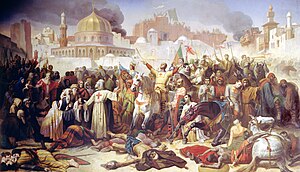
Back Belagerung von Jerusalem (1099) ALS حصار القدس (1099) Arabic Yerusəlimin mühasirəsi (1099) Azerbaijani قودس موحاصیرهسی (۱۰۹۹) AZB Обсада на Йерусалим (1099) Bulgarian জেরুসালেম অবরোধ (১০৯৯) Bengali/Bangla Setge de Jerusalem (1099) Catalan Къудс-ГӀалин гуо лацар (1099) CE Obléhání Jeruzaléma (1099) Czech Belagerung von Jerusalem (1099) German
| Siege of Jerusalem (1099) | |||||||||
|---|---|---|---|---|---|---|---|---|---|
| Part of the First Crusade | |||||||||
 Taking of Jerusalem by the Crusaders (1847) by Émile Signol | |||||||||
| |||||||||
| Belligerents | |||||||||
| Crusaders | Fatimid Caliphate | ||||||||
| Commanders and leaders | |||||||||
| Strength | |||||||||
12,200–13,300 soldiers[2][3]
| Total unknown[5] | ||||||||
| Casualties and losses | |||||||||
| ~3,000 killed and wounded[8] |
Entire garrison killed 3,000–70,000 Muslims and Jews massacred[9] | ||||||||
Site of the siege relative to the Mediterranean | |||||||||
| Part of a series on |
| Jerusalem |
|---|
 |
The siege of Jerusalem during the First Crusade lasted for one month and eight days, from 7 June 1099 to 15 July 1099 and the Christians lost alot of people during the siege. It was carried out by the Crusader army, which successfully captured Jerusalem from the Fatimid Caliphate and subsequently founded the Kingdom of Jerusalem. Having returned the city and the Church of the Holy Sepulchre to Christian rule, the siege was the final major armed engagement of the First Crusade, which had been proclaimed in 1095 to recover the Holy Land for the Christians in the context of the Muslim conquest. A number of eyewitness accounts of the battle were recorded, with the most quoted events being derived from the anonymous Latin-language chronicle Gesta Francorum.
After Jerusalem was captured, thousands of Muslims and Jews were massacred by Crusader soldiers. As the Crusaders secured control over the Temple Mount, revered as the site of the two destroyed Jewish Temples, they also seized Al-Aqsa Mosque and the Dome of the Rock and repurposed them as Christian shrines.[10] French nobleman Godfrey of Bouillon, prominent among the Crusader leadership, was elected to govern the new Christian state as the King of Jerusalem.
- ^ Valentin, François (1867). Geschichte der Kreuzzüge (in German). Translated by della Torre, Robert (2 ed.). Regensburg: Druck und Verlag von Georg Joseph Manz. OCLC 681425816.
- ^ France 1994, p. 3
- ^ Asbridge 2004, p. 308
- ^ France 1994, pp. 346–350
- ^ a b France 1994, p. 343
- ^ Asbridge 2004, p. 300
- ^ Rubenstein 2011, p. 297
- ^ France 1994, p. 131
- ^ The "massacre" at the sack of Jerusalem has become a commonplace motive in popular depictions, but the historical event is difficult to reconstruct with any certainty. Arab sources give figures of between 3,000 and 70,000 casualties (in Abu Bakr ibn al-Arabi, and in Ibn al-Athir, respectively). The latter figure is rejected as unrealistic as it is very unlikely that the city at the time had a total population of this order; medieval chroniclers tend to substantially exaggerate both troop strength and casualty figures; they cannot be taken at face value naively, and it is less than straightforward to arrive at realistic estimates based on them. For a further study of the Arab accounts see Hirschler, Konrad (2014). The Jerusalem Conquest of 492/1099 in the Medieval Arabic Historiography of the Crusades: From Regional Plurality to Islamic Narrative.
- ^ France, John. "Jerusalem, Siege of (1099)". In The Crusades – An Encyclopedia, Alan V. Murray, ed. pp. 677–679.
© MMXXIII Rich X Search. We shall prevail. All rights reserved. Rich X Search
